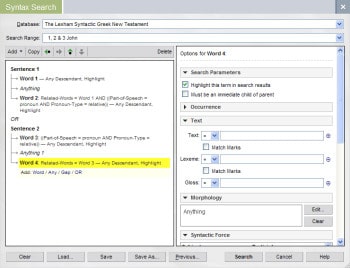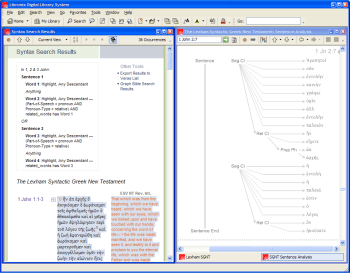When working through a passage, it can be important to work through pronoun usage. Sometimes pronouns have direct referents, sometimes the referents are implied.
A familiar example is found in the first three verses of First John:
1 That whicha was from the beginning, whichb we have heard, whichc we have seen with our eyes, whichd we looked upon and have touched with our hands, concerning the word of life— 2 the life was made manifest, and we have seen it, and testify to it and proclaim to you the eternal lifef, whichf was with the Father and was made manifest to us— 3 that whiche we have seen and heard we proclaimabcde also to you, so that you too may have fellowship with us; and indeed our fellowship is with the Father and with his Son Jesus Christ. (1Jn 1.1-3, ESV)
In the above, the English words translated from relative pronouns are in bold, the pronoun referent is in bold italic text. Note use of superscript letters to align pronoun with specific referent as there are two referents in the above example.
How did I know that? Well, let’s just say that the Lexham Syntactic Greek New Testament and the Syntax Search dialog are my friends.
As mentioned in a previous post, The OpenText.org Syntactically Annotated Greek New Testament introduces the concepts of word groups and modifiers to show how words within discrete groups modify each other.
The Lexham Syntactic Greek New Testament approaches this a little differently. In the Lexham SGNT, a relationship between words is tagged at the word level, thus words that have some sort of established relationship whether they’re in the same group or clause or not record the other words to which they are related.
Sounds weird, I know. But it is important to understand when thinking of the Lexham SGNT. When one word is related to another word for some reason or another, the Lexham SGNT records the relationship.
This brings us to the above example of First John chapter one. The first three verses contain a series of relative pronouns, the reader doesn’t learn the pronoun referent until the middle of verse three. All of the “which” statements end up referring to that which “we proclaim”.
In the Lexham SGNT, each of the relative pronouns specifies the relation between “which” and “we proclaim” (I’m using the English words here, the relationship is actually specified in the Greek.) This means that we can use some morphological information (words tagged as relative pronouns) and the related words information that the Lexham SGNT provides to search for the things that relative pronouns are related to; the sorts of relationships that exist between relative pronouns and their explicit referents.
As seems to be my developing habit, I’ve captured a video (Flash, approx. 11 megs, no sound, 5:22) of me specifying this query and running it (for the Johannine Epistles). Check it out. I’ll walk through some of the finer points below, they will likely only make sense after you see the video. So sit back, get some popcorn to chomp on if it is handy, and enjoy the ride. It’s a single take, it’s kind of jittery, and I actually end up highlighting a known bug in the way some syntax queries are rendered in the ESV NT Reverse Interlinear, but you should get the idea.
Ok, so you’ve watched the video? Good. Here are a few further notes on the specification of the query. But before we start, an important principle to remember when constructing syntax searches:
This may seem elementary, but it is important to remember. Why? Because when you remember this, you will remember that order of specified terms or structure you specify as you build the query is the order of the terms or structure you will find. Now, with that out of the way …
First, we are specifying where a sentence contains a word (at any level), followed by anything, followed by another word (at any level). There is no need for the two words to be in the same clause, this is why I’ve un-checked the Must be an immediate child of parent checkbox.
But there is need for the words to be in a particular order because
In the first specified sentence, we have a word that is simply any word called
- It is a relative pronoun as specified by morphology
- In its related word tagging, it specifies Word 1 as a related word
This brings up the way in which related words are specified. What we are searching for is where there is
I specified the related word information on Word 2 on purpose. This is the only way it will work. In queries that use agreement, there are always two pieces that are being checked for agreement. When checking for agreement, the search engine
Realizing this, we specify the agreement we desire on the second item so that the search engine can look back across information it has processed and find the match we require.
This is an important concept regarding agreement, perhaps you should read the previous two paragraphs again to underscore it in your brain.
Ok, then we have an OR to show alternation. And then we have the alternate sentence, labelled
You’ll also notice that I specified
Further Notes
You’ll notice that I bounded the search to a sentence. This is so that we could have alternates using the OR structure. Had I inserted the OR after the second word without a sentence to bound, it wouldn’t have found what I was looking for. If using an OR, a bounding structure of some sort is needed. The sentence filled this requirement for me.
However, I don’t think it is syntactically necessary for a relative pronoun and its explicit referent to be in the same sentence. In this case, I’m losing those hits. To find those hits would require two searches similar to each of our OR sentences, only without the sentence bounding.






